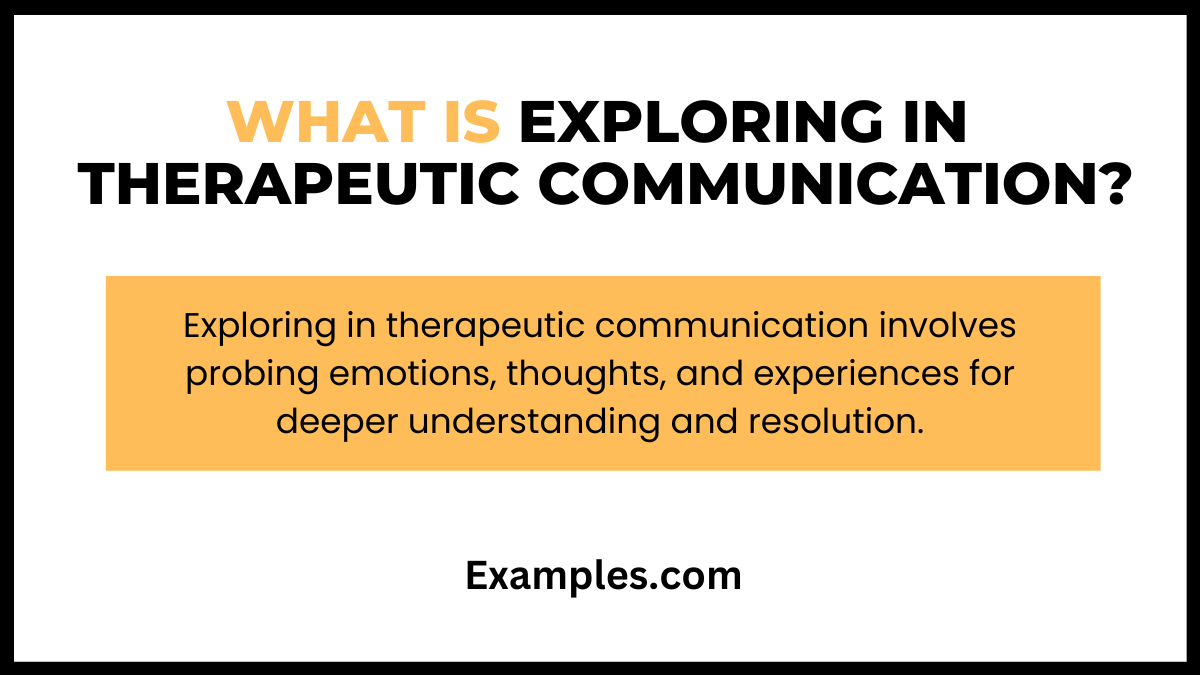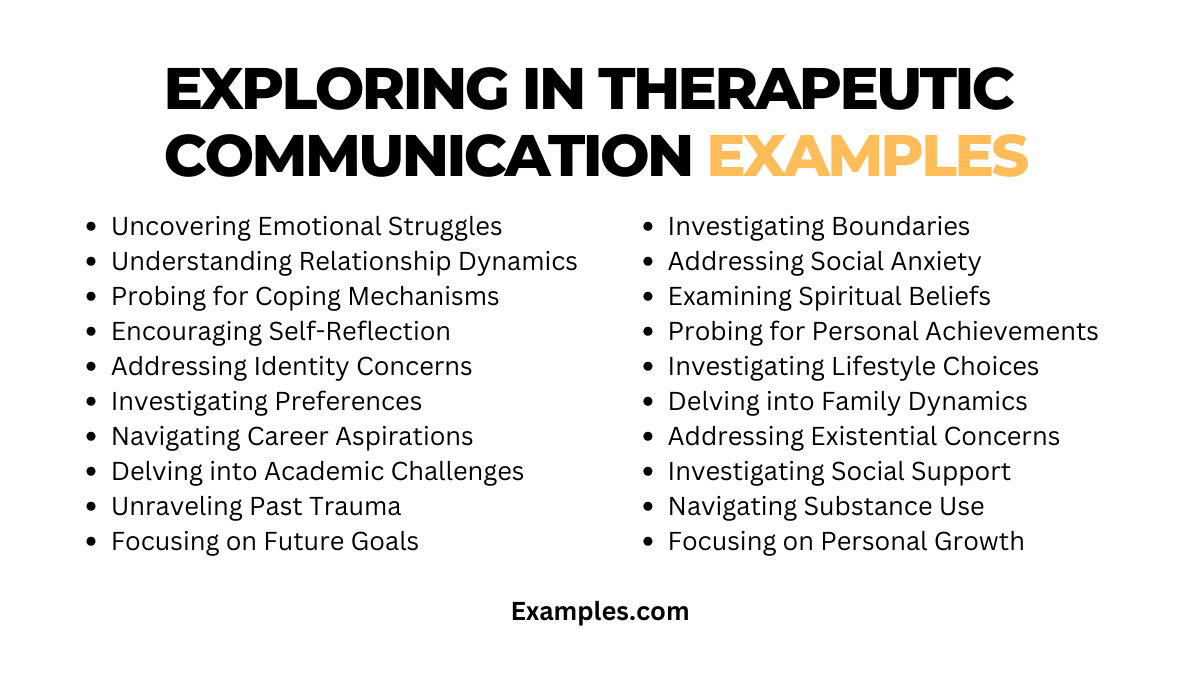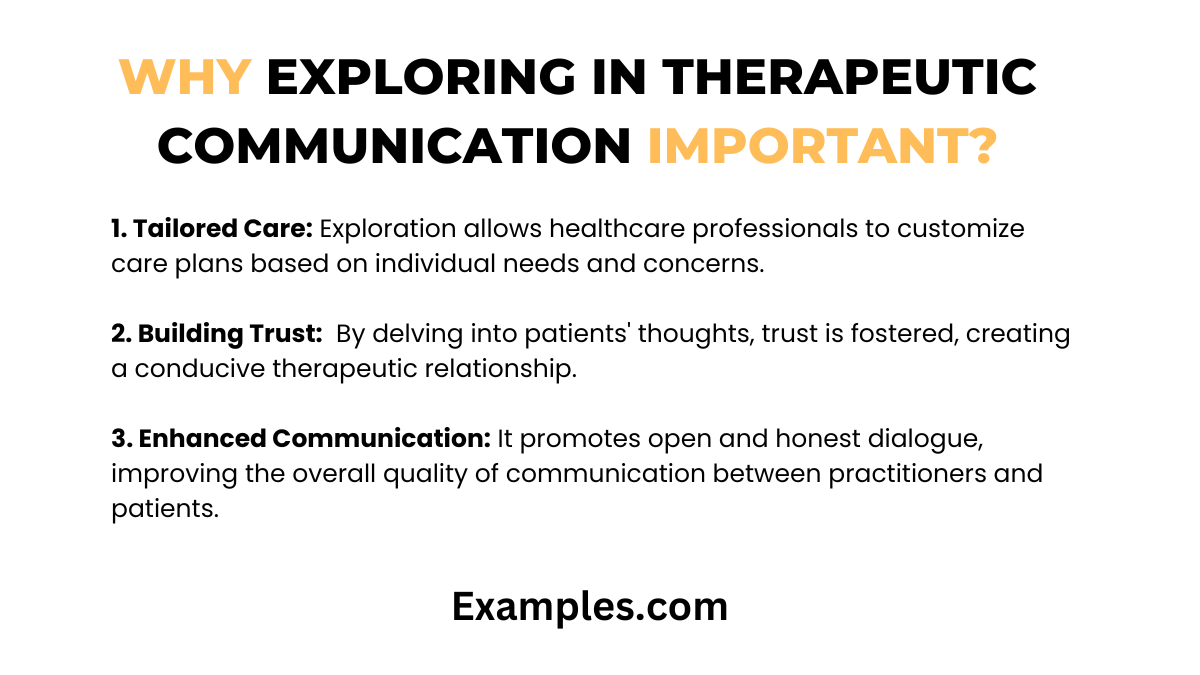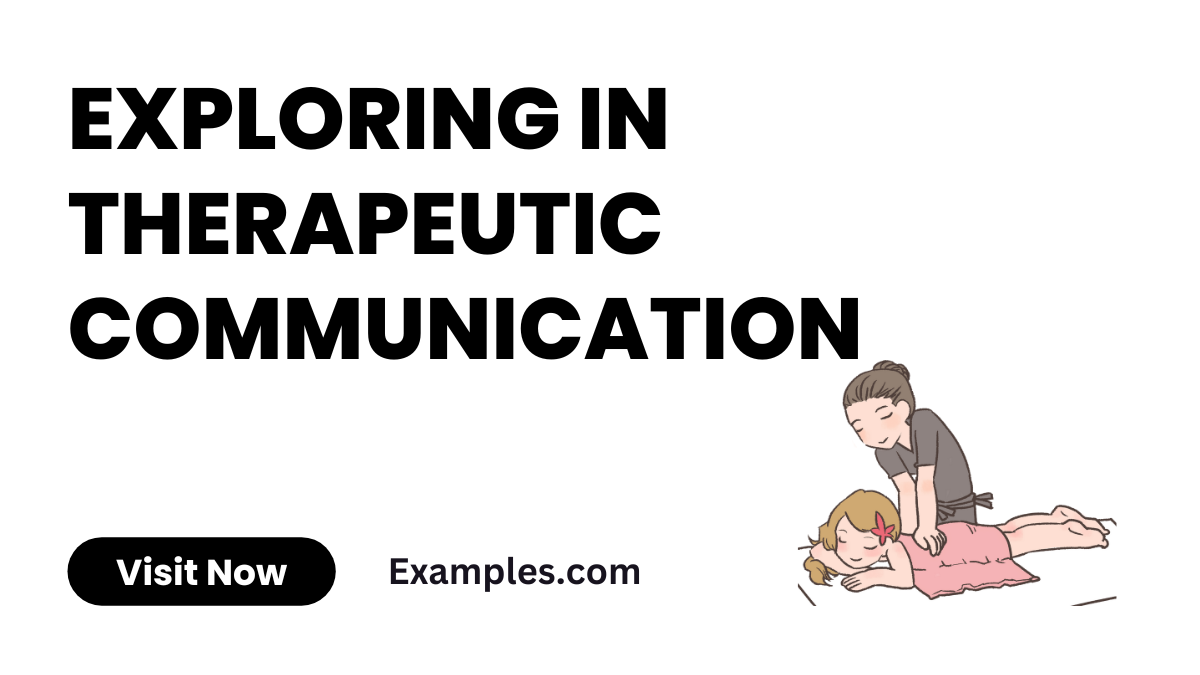19+ Exploring in Therapeutic Communication Examples
Embark on a transformative journey with our “Exploring in Therapeutic Communication” guide. Unlock a wealth of insights, techniques, and communication examples that empower meaningful connections. Discover the art of navigating emotions, building trust, and fostering growth in therapeutic interactions. This comprehensive guide illuminates the path to effective exploration, offering invaluable tips for both practitioners and individuals seeking a richer, more profound communicative experience.
What is Exploring in Therapeutic Communication?

Exploring in therapeutic communication is a dynamic process where practitioners delve into an individual’s thoughts, emotions, and experiences, fostering a deeper understanding. This intentional exploration creates a safe space for dialogue, enabling practitioners to uncover underlying issues, build trust, and guide individuals toward self-discovery. This technique involves asking open-ended questions, active listening, and empathetic responses, providing a comprehensive framework for navigating the complexities of human emotions and relationships.
20 Exploring in Therapeutic Communication Examples

In therapeutic communication, exploring involves skillful questioning and active listening to uncover a person’s thoughts and emotions. Practitioners employ open-ended queries to encourage self-reflection and expression. For instance, exploring may involve asking about fears, aspirations, or past experiences. This technique facilitates a collaborative journey of understanding, guiding individuals to explore their inner world and fostering a trusting therapeutic relationship. The examples showcase the versatility of exploring in addressing diverse emotional and psychological dimensions.
- Uncovering Emotional Struggles Explore deep-seated emotions by asking, “Can you share what emotions surface during challenging moments?” This aids in identifying underlying struggles for targeted support.
- Understanding Relationship Dynamics Navigate relationships by inquiring, “How do you perceive your role in this relationship?” Understanding dynamics fosters healthier connections and conflict resolution.
- Probing for Coping Mechanisms Discover coping strategies with questions like, “What methods bring comfort during stressful times?” Identifying effective coping mechanisms promotes emotional resilience.
- Encouraging Self-Reflection Encourage reflection by asking, “How do you interpret your recent experiences?” This empowers individuals to gain insights and foster personal growth.
- Addressing Identity Concerns Explore identity by posing questions like, “Can you share aspects of your identity that feel significant?” Acknowledging identity promotes self-acceptance and understanding.
- Investigating Communication Preferences Understand communication styles with inquiries such as, “How do you prefer to communicate in challenging situations?” Adapting to preferences enhances effective interactions.
- Navigating Career Aspirations Explore professional goals by asking, “What aspirations drive your career choices?” Navigating aspirations together helps in setting realistic and fulfilling career paths.
- Delving into Academic Challenges Address academic struggles by inquiring, “How do you approach challenges in your studies?” Exploring effective coping strategies aids in overcoming educational hurdles.
- Unraveling Past Trauma Uncover past trauma with questions like, “Can you share experiences that may have left a lasting impact?” Gentle exploration supports healing and resilience.
- Focusing on Future Goals Explore future aspirations by asking, “What goals would you like to achieve in the next year?” Guiding individuals in envisioning goals promotes motivation and purpose.
- Investigating Interpersonal Boundaries Understand personal boundaries with questions like, “What boundaries are essential in your relationships?” Exploring boundaries ensures healthy and respectful connections.
- Addressing Social Anxiety Explore social anxiety with inquiries such as, “How do social situations impact your well-being?” Navigating anxiety together supports the development of coping strategies.
- Examining Spiritual Beliefs Understand spiritual beliefs by asking, “Can you elaborate on the role of spirituality in your life?” Exploring beliefs fosters a sense of purpose and connection.
- Probing for Personal Achievements Discover personal achievements with questions like, “What milestones are you proud of?” Acknowledging successes contributes to a positive self-perception.
- Investigating Lifestyle Choices Explore lifestyle choices with inquiries such as, “How do your lifestyle choices impact your overall well-being?” Understanding choices aids in promoting a balanced and healthy life.
- Delving into Family Dynamics Understand family dynamics with questions like, “Can you describe your role within your family?” Navigating family relationships contributes to a holistic therapeutic approach.
- Addressing Existential Concerns Explore existential concerns by inquiring, “How do you grapple with existential questions?” Gentle exploration supports individuals in finding meaning and purpose.
- Investigating Social Support Understand social support with questions like, “Who do you turn to for support during challenging times?” Identifying support networks enhances resilience.
- Navigating Substance Use Explore substance use concerns by asking, “Can you share your experiences with substance use?” Gentle exploration supports individuals in seeking appropriate assistance.
- Focusing on Personal Growth Encourage personal growth by inquiring, “How do you envision your journey toward personal growth?” Guiding individuals in envisioning growth promotes motivation and resilience.
Exploring in Therapeutic Communication Examples in Nursing
In nursing, exploring aims to delve into patients’ emotions and concerns. By using sensitive queries, nurses create a supportive space for patients to share their experiences. For example:
- Easing Anxiety: How does anxiety manifest for you? Let’s explore strategies to manage it together.
- Addressing Trauma: Can you share your trauma history? Exploring helps in tailoring care to your needs.
- Understanding Grief: What memories trigger grief? Exploring aids in developing coping mechanisms for mourning.
- Encouraging Reflection: How do you perceive your progress? Exploring promotes self-reflection and empowerment.
- Identifying Needs: What specific needs arise during illness? Exploring ensures a holistic approach to patient care.
Exploring in Therapeutic Communication for Sales in Real Life
In sales, exploring involves understanding clients’ motivations and challenges to tailor solutions effectively. Through thoughtful questions, sales professionals build rapport and offer personalized assistance. For instance:
- Identifying Needs: What goals drive your purchase decisions? Exploring uncovers clients’ specific requirements for tailored recommendations.
- Handling Objections: Can you share concerns about the product? Exploring objections allows addressing issues and fostering confidence.
- Understanding Preferences: How do you envision using our services? Exploring preferences guides in presenting suitable options.
- Building Trust: What expectations do you have? Exploring creates transparency, enhancing trust in the sales process.
- Clarifying Goals: What outcomes are you aiming for? Exploring goals aids in aligning products/services with client expectations.
Why Exploring in Therapeutic Communication Is Important?

Exploring in therapeutic communication serves as a crucial element, facilitating a deeper understanding of patients’ emotions and experiences. Its importance lies in:
- Tailored Care: Exploration allows healthcare professionals to customize care plans based on individual needs and concerns.
- Building Trust: By delving into patients’ thoughts, trust is fostered, creating a conducive therapeutic relationship.
- Enhanced Communication: It promotes open and honest dialogue, improving the overall quality of communication between practitioners and patients.
- Holistic Approach: Exploration ensures a comprehensive understanding of patients, considering emotional, psychological, and physical aspects.
- Empowerment: Patients feel empowered as they actively participate in their care, contributing to decision-making processes.
How Exploring in Therapeutic Communication Is Helpful to Patients?
Exploring plays a pivotal role in benefiting patients in various ways:
- Emotional Release: Patients find a safe space to express emotions, leading to emotional relief and catharsis.
- Identification of Needs: It helps identify unmet needs, enabling healthcare providers to address them effectively.
- Understanding Perspectives: Patients feel understood, reducing feelings of isolation and promoting mental well-being.
- Coping Strategies: Through exploration, patients can discover and develop coping strategies for challenging situations.
- Promoting Self-Reflection: Encourages patients to reflect on their experiences, fostering self-awareness and personal growth.
Describe the Roles of Exploring in Therapeutic Communication?
Roles of exploring are multi-faceted, contributing significantly to the therapeutic process:
- Facilitating Dialogue: It opens channels for meaningful conversations, allowing patients to share their experiences.
- Assessment Tool: Exploration serves as a diagnostic tool, aiding practitioners in assessing patients’ mental and emotional states.
- Tailoring Interventions: By understanding patients’ perspectives, interventions can be customized for maximum effectiveness.
- Empathy Building: Practitioners cultivate empathy by actively engaging in patients’ narratives during exploration.
- Problem Identification: Exploration helps identify underlying issues, enabling targeted interventions for improved outcomes.
In conclusion, exploring in therapeutic communication emerges as a vital guide, fostering deeper connections between healthcare providers and patients. Through real-world examples and a comprehensive approach, this guide highlights the significance of exploration in understanding, empathizing, and tailoring care. It empowers practitioners to navigate diverse patient experiences, ultimately enhancing the effectiveness and humanity of therapeutic communication.



